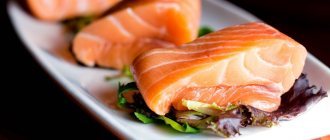A disease of the pancreas changes the usual lifestyle of a previously healthy person. You have to give up a number of familiar foods, sweets and drinks, and change the way you prepare many dishes. A delicious fatty, fried, peppered, salty product goes into oblivion. In case of primary signs of the disease and with proper treatment, you can try to gradually return to your usual diet. Just don’t go overboard with treats and don’t overeat.
Eating fish and seafood becomes part of a healthy diet, along with dairy, fermented milk and meat products. As you know, omega acids, which fish and fish oil are rich in, normalize and reduce cholesterol levels. There is a natural regulation of metabolism in cells.
Fish is a product enriched with protein, a valuable, easily digestible element. Seafood contains selenium, which prevents the influence of harmful environmental factors.
Fish oil is indispensable for the body. It is much easier to digest than animal fats. Patients with pancreatitis with the specified type of products need to be selective. Is fish allowed for pancreatitis? A partial answer is presented taking into account medical recommendations.
According to medical practice, low-fat varieties of fish are considered acceptable for food for a patient.
The selected varieties of fish for pancreatitis should show a fat content of 0.3-0.9 percent. Selected species of fish are included in the dietary list.
Marine:
- cod;
- haddock;
- navaga;
- polar cod;
- whiting;
- pollock;
- mullet;
- pollock;
- flounder;
- silver hake;
- vobla.
River:
- zander;
- bream;
- pike.
The species described below exhibit moderate fat content in sizes of 4.2 - 6.4 percent. It is not forbidden to cook the specified fish for pancreatitis.
Marine:
- tuna;
- chum salmon;
- horse mackerel;
- catfish;
- pink salmon;
- trout;
- herring;
- lean herring.
River:
- carp;
- catfish;
- crucian carp;
- bream;
- perch.
Fish oil that is absent from the body or present in small quantities does not at all make a seafood product of little use. The amino acids contained in fish are important for the body.
When preparing seafood, give preference to the boiled type, steamed cutlets, and steamed food.
A categorical “no” – smoked, canned, fried fish. Fish soup is contraindicated.
Preserves
People suffering from pancreatitis are forced to constantly follow a strict diet. Some foods can be consumed in small doses, others only during certain periods, and others are strictly prohibited.
It must be said that pancreatitis is an inflammation of the pancreas, which can occur in both chronic and acute forms. A mild degree of the disease can go away on its own, or with the help of a special diet, which is indicated for all patients with pancreatitis.
People with this diagnosis can eat fish, but only in stewed, boiled and steamed form. However, only certain varieties are allowed, with a fat content of no more than 8% (cod, pollock, hake, flounder and others).
Is it possible to have pink salmon?
For various disorders of the digestive system and gastrointestinal tract disorders, for inflammation of the pancreas, the use of pink salmon is allowed. The amount of nutrients it contains improves the functioning of the body.
Among the beneficial properties of pink salmon is the presence of omega-3 acids and nicotinic acid. Speaking about the first, we mean the normalization of cholesterol, the second provides a beneficial effect on the functioning of the gastrointestinal tract and duodenum. Amino acids of this group have an antioxidant effect on the structure of DNA. This is the hidden elixir of youth for the body's cells.
But dried – under no circumstances!
However, dried fish, despite its beneficial composition, is strictly prohibited for those suffering from this disease. The fact is that salt, which is found in excess in dried fish, irritates the mucous membrane of the pancreas, causing it to become active and produce an enzyme. Thus, salt provokes an inflammatory process in the diseased organ. Such a reaction can lead to suppuration, swelling and even necrosis of this organ. Therapeutic treatment of this disease is aimed at inhibiting processes in the gland and weakening its work.
When pancreatitis worsens, not only the pancreas itself suffers, but also other vital organs - kidneys, stomach, liver. In this case, it does not matter what type of fish, fatty or low-fat, any salted fish is prohibited.
However, there are still rare occasions when you can eat small quantities of dried fish. We are talking about a period of stable remission. But there are also many important nuances here: it is best to eat home-cooked fish, where a minimum of harmful additives and spices that irritate the pancreas were used. When salting fish, it is recommended to use as little salt as possible so as not to aggravate the disease.
You can include dried and dried fish in your diet only with the permission of a doctor and under strict supervision. It should not be forgotten that dried fish is dangerous for patients with pancreatitis at any stage. Fish lovers should prefer more gentle dishes - steamed or boiled fish.
Fish gold - the strictest taboo
Caviar is a delicacy, preferred by many gourmets, a storehouse of vitamins A, B, D, E and microelements, valuable proteins, light fats, and polyunsaturated fatty acids. Caviar is recommended for young children and patients recovering to quickly replenish lost minerals, iron and lecithin - a complex of phospholipids that promote the proper functioning of brain cells and the body.
The product characteristics are the highest. The rich composition seems to have no contraindications for use. However, red caviar for pancreatitis is taboo. Doctors categorically prohibit consumption on days of exacerbation of pancreatic disease.
The significant content of table salt and cholesterol in the ready-to-eat product places red caviar in the rank of risk group products. Eating a delicacy provokes stress for the body in chronic forms of the disease and will aggravate the patient’s condition, with unpredictable consequences.
During long-term remission, doctors allow you to eat no more than a gram of the delicacy to satisfy an extreme need. Eating red caviar is only allowed on a full stomach. It is also necessary to take into account the quality of the product and non-handicraft production.
High-quality caviar has a number of obvious differences: a dense consistency, the color is pale pink to deep red, the eggs scatter and do not stick together. If unusual symptoms are felt after eating caviar, it is recommended to immediately take the prescribed drug or consult a doctor.
Types of chum salmon
The Frost-Fish online store sells an Asian subspecies of chum salmon caught in fresh waters of the Russian Federation. Red fish spawn in different rivers.
Based on its habitat, it is divided into several subspecies:
- Amur lives in the rivers of the Amur basin, Primorsky and Khabarovsk territories;
- Sea of Okhotsk - in the south, north and east of Sakhalin;
- Sakhalin - in the west of Sakhalin;
- northern - in the Chukotka District and the Kamchatka Peninsula;
- Kunashir.
southern - in the Far Eastern region of Primorye, the islands of the Kuril ridge and
Externally, the subspecies are similar, differing in the timing and duration of spawning. The Sakhalin chum salmon is characterized by a pronounced color of a silvery hue with green splashes in comparison with individuals of other species forms.
How to choose and store correctly
Best materials of the month
- Coronaviruses: SARS-CoV-2 (COVID-19)
- Antibiotics for the prevention and treatment of COVID-19: how effective are they?
- The most common "office" diseases
- Does vodka kill coronavirus?
- How to stay alive on our roads?
Catfish are selected according to the same rules as other fish. Her eyes should be clear, without a cloudy “curtain”. Fresh meat is elastic and light, it springs back when pressed with your fingers and quickly returns to its former shape.
In the freezer, fish will retain its taste and nutritional properties for 2 months. Fresh fillets are stored in the refrigerator for no longer than two days, and it is advisable to eat catfish dishes within 24 hours.
general characteristics
Catfish is a sea fish from the Perciformes. Mainly found in the north Atlantic Ocean, near Russia, Canada and even in the western Arctic. This cold-water fish feels comfortable in waters with temperatures below 5 degrees. Spends almost all of its time in ocean waters at depths from 400 to 1200 meters below sea level. It rises to the surface in search of food.
Content:
- general characteristics
- Beneficial features
- Use in cooking
- How to choose and store correctly
- What else is useful for catfish?
Catfish is a predatory fish. Its diet consists of smaller ocean inhabitants: sea urchins, crabs, starfish. At depths, their food becomes jellyfish and smaller fish. The peculiarity of these fish is their knife-sharp teeth, thanks to which they retain a dominant role in the world's oceans. And it was thanks to these terrifying teeth that the fish got its name. And its middle name is sea wolf: like this animal, the fish’s surprisingly developed jaw has protruding fangs and teeth turned inward.
Adult representatives can reach more than a meter in length and weigh more than a hundredweight. There are several types of catfish and they all differ in color. They can be dark gray to dark brown or even purple in color.
Types of catfish
Acne. Its habitat is the shores of North America: from Alaska to California.
Far Eastern. It is found in the Pacific Ocean, mainly in its northwestern part.
Blue. Found in the north Atlantic Ocean. Despite its name, its color can range from dark gray to dark brown and even purplish-purple. The pulp of these representatives is jelly-like.
Striped. Adults reach 22 kilograms and exceed one and a half meters in length. Distributed in the waters of the White and Barents Seas, near England and Ireland. Prefers rocky bottom. The fillet is quite firm. It differs from other species by dark vertical stripes on the sides.
Spotted (variegated). This one and a half meter giant is found in northern waters. The sides and fins are covered with dark spots. The pulp is quite dense
An adult catfish, so to speak, leads a sedentary lifestyle and moves along the bottom only in exceptional cases. But the young animals “plow” the ocean almost continuously.
During the spawning period, which for catfish occurs in the summer, females lay up to 30 thousand eggs. The rather large eggs of this fish settle on rocky bottom surfaces.
The lifespan of this fish is about 12 years. Having reached maturity (at 4-5 years of age), young catfish settle on the seabed and switch to the usual lifestyle for adult relatives.
Commercial fishing is one of the most important aspects of the global economy. Catfish are also not spared from fishing nets. Recently, in addition to the traditional fishing grounds - the Barents Sea and the coast of Northern Norway, catfish are bred artificially. But it is difficult to say that this northern fish is the most popular for the industry. Some people do not like its meat due to its excessive wateriness. Another reason for the low industrial popularity is the difficult-to-reach habitats of these predators. Getting a catch from deep water is too expensive. But this does not mean that there are no people in the world who want to eat her fillet. Moreover, cooks know the secrets of how to cook it correctly, and researchers claim that it is a healthy fish.
Area
Compared to others, chum fry do not sit in one place for several years to gain weight. Their flocks swim downstream, find secluded places and stay for six months to a year in the seas near the mainland or island shores. As soon as their carcass grows 35-40 cm, they go on a long voyage at sea, where they spend the rest of their lives.
Pacific salmon easily tolerate low water temperatures and migrate through the waters of the Pacific and Arctic Oceans. Its range is the widest among its relatives. Found in the seas of Russia, Canada, USA, Japan and South Korea. It can often be seen in the Bering Strait, Far Eastern and northern rivers.
Seafood for chronic pancreatitis
During the remission phase of chronic pancreatitis, all seafood can be used - shrimp, squid, octopus, mussels, scallops, etc. They are allowed in boiled and baked form - as a main dish and for salads; you can make puree soups with them, add them to risotto, pasta, etc.
See also: recipe for squid salad with apple.
However, for pancreatitis, even during stable remission, the following categories of seafood are prohibited:
- canned, pickled and smoked;
- with hot and sour sauces (including dressings based on lemon juice and vinegar);
- sushi and rolls.
It is preferable to use fresh and fresh-frozen seafood rather than boiled and frozen. During the cooking process, it is necessary to provide sufficient heat treatment (boiling, baking, stewing) to make the dish soft.
Overall Benefits of Sea Bass
This product is very beneficial for human health. It has a rich, varied composition and supplies the body with essential substances.
Chemical composition
Perch meat is a source of nutrients, vitamins, and minerals. Its regular use helps to improve the health of the body and normalize its functioning. And this is achieved due to the large amount it contains:
- tryptophan;
- threonine;
- isoleucine;
- leucine;
- lysine;
- methionine;
- cysteine.
Perch meat contains a lot of vitamins:
- Retinol. Vitamin A helps maintain healthy skin. Its influence on the functioning of the human visual apparatus is also known.
- B vitamins: thiamine, riboflavin, panthenol, pyridoxine, cyanocobalamin, folic acid. These substances play one of the key roles in the functioning of the whole organism. They are responsible for the functioning of many systems - cardiovascular, nervous, reproductive, endocrine. B vitamins also affect skin condition and brain function.
- Calciferol. Vitamin D promotes the absorption of calcium, due to which the skeleton is formed in children, and in adults, the normal functioning of the musculoskeletal system is maintained.
- Tocopherol. Vitamin E is important for skin health. It also affects the reproductive system, especially in women. With its deficiency, the menstrual cycle fails, and dangerous gynecological diseases can develop.
Benefits of Vitamin E
In addition to vitamins, perch is high in:
- calcium;
- gland;
- magnesium;
- phosphorus;
- potassium;
- sodium;
- zinc;
- copper;
- manganese;
- Selena;
- Omega-3;
- Yoda.
This multi-component composition explains the benefits of this fish for the human body.
For women
The benefits of the product for the female body are limitless. The activity of the thyroid gland is of great importance, on which the level of not only thyroid, but also female sex hormones depends. Perch contains iodine, which is essential for the normal functioning of this endocrine organ. By normalizing the functioning of the thyroid gland, the substances contained in the meat of this representative of marine fauna help maintain the balance of estrogen in the female body. This affects many of its functions: menstrual, reproductive, etc.
Among other things, vitamins help maintain optimal condition of the skin and nails - tocopherol and retinol are primarily responsible for this.
For men
This product is also useful for the male body. The content of a whole vitamin-mineral complex in it helps maintain physical strength and normal functioning of the muscular system. The positive effect of perch meat also extends to the activity of the reproductive system. Iodine and selenium help maintain testosterone levels within normal limits.
Thus, the functioning of the genital organs improves, potency increases, and erectile function is normalized. In addition, by eating perch regularly, men have the opportunity to avoid unpleasant, even dangerous diseases, such as prostate adenoma or prostatitis.
See also:
Catfish (fish) - benefits and harms, what is good for the body











